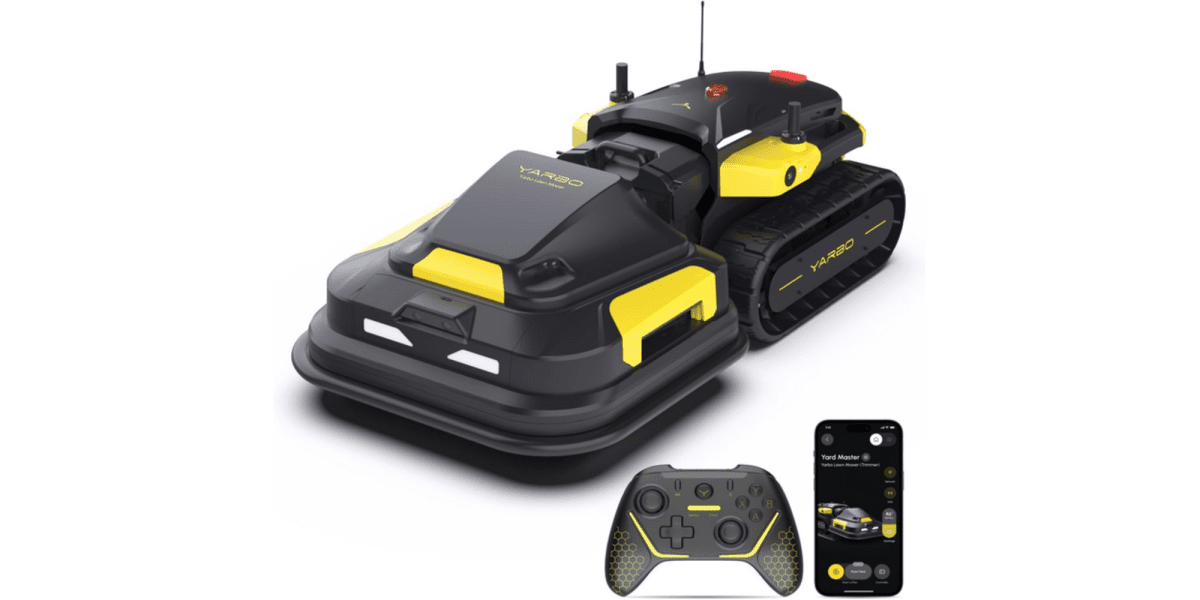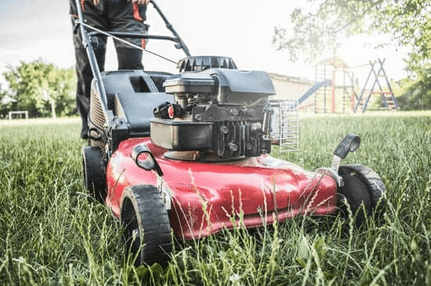Managing a big yard is no small feat, so we put the Yarbo robot mower to the test. Its remote control and smart navigation made mowing steep slopes and wide areas a lot less of a headache.
The mower adapts well to uneven ground and gets pretty close to the edges—no perimeter wire needed, which honestly saved us a ton of hassle.
It heads back to recharge on its own and then picks up where it left off. Setting up mowing zones in the app gave us more control than we expected.
While it’s a beast on slopes and tricky spots, the sheer size and weight make it less appealing for smaller yards. Not exactly the mower for a tiny patch of grass.
Bottom Line
If you’re looking to save time on mowing a big yard, the Yarbo robot mower is worth a look. It handles tough terrain and large spaces with minimal fuss.
Click here to purchase the Yarbo robot mower and get started on easier lawn maintenance today!
Overview of the YARBO Robot Lawn Mower
This mower is designed for large yards—it handles uneven ground and steep slopes more effectively than many of its competitors. The wide cutting path sped up the job, but honestly, the initial setup felt a little daunting, especially if you’re not super techy.
It squeezed through tight spots and along edges thanks to its mix of sensors and cameras. Battery life and auto-recharge worked as promised, so it’d just keep going without much fuss from us.
The modular design is a neat touch, allowing you to switch between mowing, leaf blowing, or snow clearing (if you purchase the optional extras). It’s heavy though—lugging it around by hand isn’t fun.
Key Features
After using this mower, its strengths and quirks became pretty clear. It’s made for seriously large lawns, and you can tell from how it tackles different parts of the yard.
Some features shine more than others, but for big outdoor spaces, it’s a solid machine.
Massive Lawn Coverage and Efficient Cutting
The coverage is impressive—it can handle up to 6 acres and doesn’t leave patches behind. Those wide blades get the job done fast, which is a relief if you’re used to slower models.
The cut was mostly even, though sometimes on bumpy ground it needed a second pass to tidy things up. Still, it’s a huge time saver.
Advanced All-Terrain Mobility
The tracks are built for climbing, and ours handled hills up to 70% grade without drama. It felt steady across rough patches and hard soil.
The steel skid shoes help with bumps, but they slow down in mushy mud. So, if your yard turns swampy after rain, keep that in mind—it prefers firm but uneven ground.
Smart Navigation and Edge Cutting
With GPS and cameras, the mower mapped our yard pretty well. The edge cutting was legit—it trimmed right up to fences and walls, so no weird strips left behind.
Setting up no-go zones took some fiddling, but once done, it reliably avoided flower beds and delicate spots. Not perfect, but good enough for most.
Intelligent Obstacle Detection
It uses several cameras and sensors to spot stuff in its path. It slowed down and dodged around lawn chairs or toys, but sometimes missed small low branches.
We found it’s best to clear the yard before mowing. The system helps avoid most accidents, but it’s not flawless—don’t expect magic.
Multi-Season Versatility
This mower isn’t just for summer—it adapts all year. Swap out modules, and you can blow leaves or clear snow, which is pretty cool.
The catch is that those extra modules come at an additional cost. Switching tasks is easy enough, but the initial setup isn’t instant. Still, it’s nice to have options beyond just mowing.
Charging and Zone Management
Charging is painless. The mower finds its dock when it’s low on juice, so you don’t have to babysit it.
Charging times are reasonable, and it gets back up and running pretty quickly. The multi-zone feature is a life-saver for big, complicated yards.
We set up and managed up to 10 zones, and the AI mapping skipped over areas we didn’t want mowed. It takes a little time to set up at first, but once done, it runs on autopilot.
Pros and Cons
After some real-world use, we spotted a mix of highlights and a few issues you’ll want to know about.
Pros
This mower absolutely owns large yards, even on hills and rough patches. The tracks grip well and the wide cutting deck covers ground fast.
Navigation is sharp—the cameras and GPS keep it on track, and the app lets you control zones easily. It returns to charge itself and resumes work, which is honestly a relief.
The modular design is a bonus if you want to add leaf blowing or snow clearing down the line, though that’ll cost extra.
Cons
Setup isn’t exactly plug-and-play—if you’re not into tech, expect a learning curve. The instructions are okay, but you’ll need some patience.
Some folks ran into battery issues and had to wait on replacements. The mower is quieter than gas models, but not exactly silent.
The app could be smoother, and the price tag is definitely up there compared to basic robotic mowers.
| Pros | Cons |
|---|---|
| Handles large, sloped yards with ease | Setup is not very beginner-friendly |
| Precise edge cutting and multi-zone scheduling | Battery issues reported by some users |
| Self-return and resume charging | App could be more user-friendly |
| Modular design for year-round yard work | Quieter than gas, but not silent |
Customer Reviews
Most users seem happy with how it handles big, uneven yards—even on slopes up to 70%. The AI mapping and RTK GPS let it cover weird corners pretty well.
People like that it’s quieter than gas mowers. Setup can be a pain if you’re not tech-savvy, and some folks had battery or support hiccups. But once it’s running, it really does free up your weekends.
Pros and cons in summary:
- Good: Effective on slopes, large yard coverage, quieter than standard mowers
- Needs improvement: Initial setup complexity, occasional battery and support challenges
Frequently Asked Questions
We had plenty of questions before trying this mower ourselves. Here’s what we figured out from using it and from what others have asked.
How does the YARBO Robot Lawn Mower perform on uneven lawns?
It handles rough ground better than you’d expect. The tracks grip well on slopes up to about 70%, and the flexible frame helps it roll over bumps.
It stays pretty stable, but sharp drops or deep holes can still trip it up—best to mark those in the app or avoid them.
Can the YARBO Robot Lawn Mower efficiently handle large gardens?
Absolutely. It’s made for yards up to 6 acres. We tested it on a mid-sized lawn, and it quickly covered the ground with its wide blades.
For really big spaces, setting up zones and schedules worked best to make sure it didn’t miss spots or get stuck.
What is the battery life and charging time for the YARBO Robot Lawn Mower?
It runs for a couple of hours before needing to be recharged. When the battery drops to approximately 20%, it returns to the dock on its own.
Charging takes about 1-2 hours so that it can keep up with daily mowing pretty much on autopilot.
What maintenance is required for the YARBO Robot Lawn Mower?
Maintenance is straightforward. We cleaned the blades and wheels regularly to prevent grass build-up.
The tracks and sensors require occasional inspection for dirt or damage. Swapping dull blades is part of the deal, but overall, it’s less work than a regular mower.
Are there customizable settings available on the YARBO Robot Lawn Mower?
The app offers a range of options, including cutting height, schedules, no-go zones, and multi-zone mapping. We split the lawn into sections to mow on different days, which made life easier.
This flexibility means you don’t have to deal with wires or make constant manual adjustments. It fits well into odd-shaped yards.
How does the YARBO Robot Lawn Mower compare to other leading brands in terms of features and value?
Honestly, compared to other robot mowers we’ve tried or seen around, YARBO stands out for its ability to handle steep slopes and cover large lawns. The navigation is smarter, thanks to multiple cameras and GPS tech—it’s just more precise.
The modular design allows you to swap out attachments, which is quite rare in this space. On the other hand, the initial setup can be somewhat challenging. It’s also heavier than many models on the market, so that might be a dealbreaker for some individuals.
DISCLAIMER
This document is provided for general information purposes only and should not be relied upon as providing legal advice, technical, or specific operational guidance to the reader, whether as to the practices described in the document or the applicable legal requirements and regulations. lawnfly.com expressly disclaims any responsibility for liability arising from or related to the use or misuse of any information in this document.





